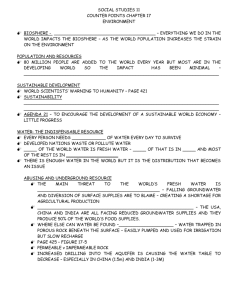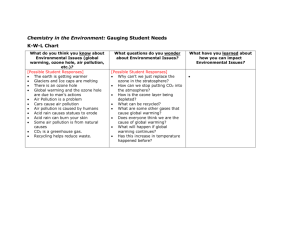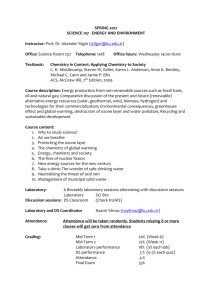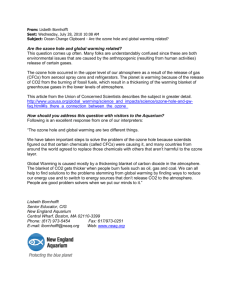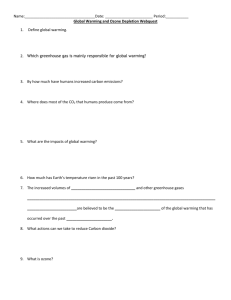Socials 11 - ACRSS eLearning Site
advertisement
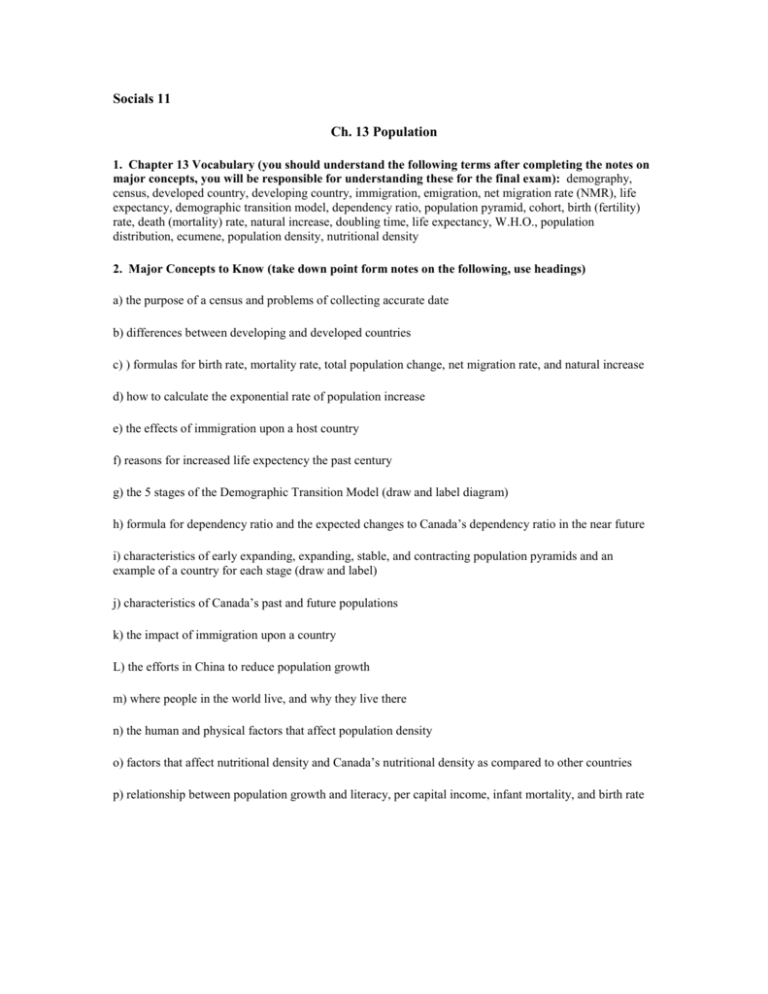
Socials 11 Ch. 13 Population 1. Chapter 13 Vocabulary (you should understand the following terms after completing the notes on major concepts, you will be responsible for understanding these for the final exam): demography, census, developed country, developing country, immigration, emigration, net migration rate (NMR), life expectancy, demographic transition model, dependency ratio, population pyramid, cohort, birth (fertility) rate, death (mortality) rate, natural increase, doubling time, life expectancy, W.H.O., population distribution, ecumene, population density, nutritional density 2. Major Concepts to Know (take down point form notes on the following, use headings) a) the purpose of a census and problems of collecting accurate date b) differences between developing and developed countries c) ) formulas for birth rate, mortality rate, total population change, net migration rate, and natural increase d) how to calculate the exponential rate of population increase e) the effects of immigration upon a host country f) reasons for increased life expectency the past century g) the 5 stages of the Demographic Transition Model (draw and label diagram) h) formula for dependency ratio and the expected changes to Canada’s dependency ratio in the near future i) characteristics of early expanding, expanding, stable, and contracting population pyramids and an example of a country for each stage (draw and label) j) characteristics of Canada’s past and future populations k) the impact of immigration upon a country L) the efforts in China to reduce population growth m) where people in the world live, and why they live there n) the human and physical factors that affect population density o) factors that affect nutritional density and Canada’s nutritional density as compared to other countries p) relationship between population growth and literacy, per capital income, infant mortality, and birth rate Socials 11 Ch. 14 Living Standards 1. Chapter 14 Vocabulary (you should understand the following terms after completing the notes on major concepts, you will be responsible for understanding these for the final exam): Human Development Index, per capita, GDP (gross domestic product), infrastructure,highly indebted country, poverty, multinational company, UNICEF, pandemic, bilharzia, malaria, E coli, multilateral aid, tied aid, NGO 2. Major Concepts to Know : (take down point form notes on the following, use headings) a) factors used to measure the Human Development Index and countries at the top and bottom of the list b)differences between developing, developed and HIPC’s c) difficulties in comparing living standards d) different measures of poverty and why poverty varies from country to country e) groups in Canada that are most likely to experience poverty f) original goals of the World Bank and IMF g) problems associated with the policies of the World Bank and IMF h) reasons why Kenya is experiencing economic problems i) steps that Canada and other developed countries are taking to assist HIPC’s j) problems experienced by women in some developing countries k) role of education in improving women’s position l) Child Risk Ratio: what is it and how is it measured? m) problems experienced by Canada’s aboriginal communities n) reasons for high under five mortality rate in developing countries o) problems of child labour p) diseases caused by contaminated water q) reasons for and problems created by the AIDS epidemic in Africa r) different types of foreign aid s) role of NGO’s in the world today SS 11 Ch. 15 Urbanization 1. Chapter 15 Vocabulary (you should understand the following terms after completing the notes on major concepts, you will be responsible for understanding these for the final exam): urbanization, inmigration, shanty town, push factor, pull factor, urban functions, site, situation,basic activities, non-basic activities, multiplier effect, suburb, urban sprawl, peak-value intersection, sustainable city, infilling 2. Major Concepts to Know : (take down point form notes on the following, use headings) - reasons for increased urbanization in the 1900’s - current urbanization (see map page 368) - millionaire cities (see chart 15-5 page 369) - problems associated with shanty towns - problems experienced by street children - difference between pull and push factors - difference between site and situation - locational advantage - differences between basic and non basic activities - multiplier effect - 5 patterns of city forms draw and label Figure 15-15 - problems associated with increased automobile use - advantages and disadvantages of urban sprawl - categories of land use (figure 15-18) and examples of each category in the western communities - competition for land - reasons for land-use zoning and official plans - qualities of sustainable cities - problems faced by cities and ways to increase sustainability - energy consumption by continent (see Figure 15-27) SS 11 SS 11 Chapter 16: Patterns in Economic Development 1. Chapter 16 Vocabulary (you should understand the following terms after completing the notes on major concepts, you will be responsible for understanding these for the final exam): economic disparity, economy, primary industry, secondary industry, tertiary industry, natural resource, agglomeration, economic core, periphery, industrial heartland, out-migration, traditional economy, subsistence agriculture, agribusiness, scarcity, renewable resource, nonrenewable resource, decentralization, sunset industry, equalization payment 2. Major Concepts to Know : (take down point form notes on the following, use headings) - concept of economic disparity - primary, secondary, and tertiary activities - the differences between economic core and periphery - Canada’s industrial heartland -factors leading to a disadvantaged periphery - the percent of the world’s work force in primary industries (figure 16-12) - basic characteristics of traditional, developing, and developed economies - the factors important in encouraging development - factors connected with a lower level of economic development - reasons for low internet use in developing countries - incentives for decentralization and industries that are best suited to be moved - examples of sunset industries - traditional and present economy of Tumbler Ridge SS 11 Chapter 17: Environment 1. Chapter 17 Vocabulary (you should understand the following terms after completing the notes on major concepts, you will be responsible for understanding these for the final exam): biosphere, Agenda 21, groundwater, aquifer, surface water, ozone layer, CFC’s, global warming, fossil fuels, permafrost, Kyoto Protocol, desertification, GM crops, biodiversity, boreal forest, stewardship, ecotourism 2. Major Concepts to Know: (take down point form notes on the following, use headings) a) distribution and use of the world’s natural resources b) major environmental initiatives and their results (Agenda 21, Kyoto Protocol) c) forms and percentages of fresh water found in the world d) reasons for the decrease in available surface water and groundwater for human use e) advantages and disadvantages of using aquifers for farming f) cause and effects of fluorosis g) sources and effects of surface water pollution h) value of the ozone layer i) reasons for the destruction of the ozone layer (include a breakdown of how much each continent contributes to ozone depletion) j) factors that contribute to global warming k) general problems associated with global warming l) specific threats to Canada created by global warming m) benefits of global warming n) alternate sources of energy that could reduce fossil fuel consumption (including theBallard fuel cell) o) causes of desertification p) harmful effects of pesticides q) Canadian and European policy on GM foods r) advantages and disadvantages of GM foods s) reasons for and problems with the destruction of the tropical rain forests t) reasons for and problems with the destruction of Canada’s boreal forests u) value of Canada’s coastal forests v) advantages and disadvantages of ecotourism
